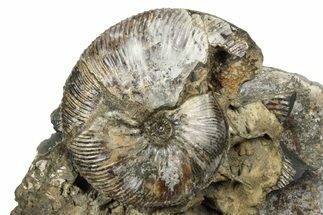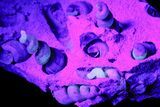This Specimen has been sold.
Fluorescent Fossil Gastropods in Limestone - Russia
This is a stunning chalcedony replaced gastropod cluster from the permian limestone deposits of Shikhany, Russia. The outer shell of these gastropods have been prepped away to reveal their spiral shaped, chalcedony replaced living cavities. There is also pyrite replacement proximal to the outer lip location of each gastropod.
A unique feature of this specimen is the chalcedony which fluoresces white under both short and long-wave UV. The majority of this fluorescence occurs near the apex end of two of the gastropods. Included above is a photo of the fossil fluorescing under long-wave UV.
A unique feature of this specimen is the chalcedony which fluoresces white under both short and long-wave UV. The majority of this fluorescence occurs near the apex end of two of the gastropods. Included above is a photo of the fossil fluorescing under long-wave UV.
Gastropods, or snails, have been around since the Late Cambrian period. The class Gastropoda contains a vast total of named species, second only to the insects in overall number. There are 611 known families of gastropods, of which 202 families are extinct and appear only in the fossil record.
About Quartz
Quartz is the name given to silicon dioxide (SiO2) and is the second most abundant mineral in the Earth's crust. Quartz crystals generally grow in silica-rich environments--usually igneous rocks or hydrothermal environments like geothermal waters--at temperatures between 100°C and 450°C, and usually under very high pressure. In either case, crystals will precipitate as temperatures cool, just as ice gradually forms when water freezes. Quartz veins are formed when open fissures are filled with hot water during the closing stages of mountain formation: these veins can be hundreds of millions of years old.
Quartz is the name given to silicon dioxide (SiO2) and is the second most abundant mineral in the Earth's crust. Quartz crystals generally grow in silica-rich environments--usually igneous rocks or hydrothermal environments like geothermal waters--at temperatures between 100°C and 450°C, and usually under very high pressure. In either case, crystals will precipitate as temperatures cool, just as ice gradually forms when water freezes. Quartz veins are formed when open fissures are filled with hot water during the closing stages of mountain formation: these veins can be hundreds of millions of years old.
SPECIES
Unidentified Gastropod
AGE
LOCATION
Shikhany, Volga River, Russia
SIZE
3.5 x 2.1" limestone, largest gastropod about 1" long
CATEGORY
ITEM
#174902
We guarantee the authenticity of all of our specimens.
 Reviews
Reviews















